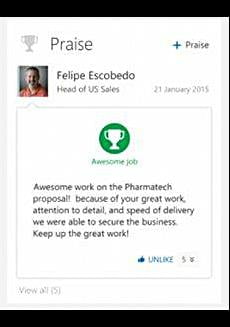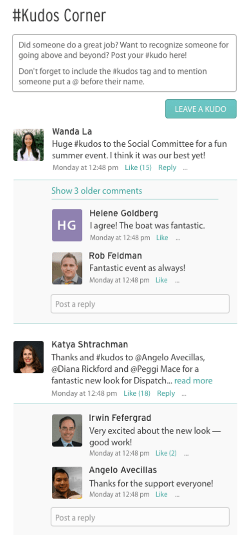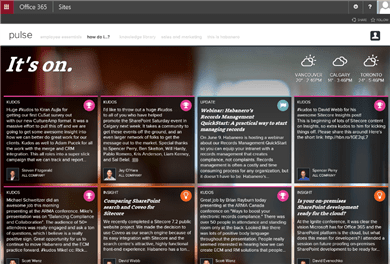
Recently, Microsoft announced its machine learning knowledge discovery platform, Office 365 Delve, will be expanded to include employee praise functionality. In a similar method to what’s already possible in enterprise social tools like Yammer, employees will soon be able to recognize fellow coworkers for a job well done, include a comment, and select from a collection of praise icons. This praise card is then immediately visible to all employees, who can ‘like’ or comment on the post.
This news prompted me to reflect on some lessons Habanero’s learned related to recognition systems:
- Employee portals provide an excellent platform for recognition and building a culture of positive reinforcement; an effective portal or intranet can engage people from all corners of an organization much faster than offline approaches.
- Simple recognition capabilities are often just as effective, if not more so, than complex systems that involve points, gamification, or reward incentives.
- Peer-to-peer recognition has just as much impact as top down recognition.
- Recognition capabilities can thrive regardless of perceived cultural readiness.

In the few months since The Junction—the Royal College of Dental Surgeons of Ontario’s intranet— has launched, the organization has experienced a steady uptake in popularity of their employee kudos capability. The College uses SharePoint 2013’s social newsfeed capability as a simple but popular means to shine a light on employee contributions in the workplace. The employee Kudos Corner widget is featured prominently on The Junction’s homepage and is open for anyone to either add a new kudos or comment and like an existing post.
The College has observed through portal measurement and analytics that more than 50 per cent of employees have left a kudos or commented on an existing post. The popularity of this feature echoes what we’ve heard from to other clients as well.
It’s also important to note that this type of kudos feature is often a great way to encourage repeat traffic to your intranet, because it acts as a draw for users to eventually navigate to areas where they may consume other important content.
Having an employee recognition capability available and easily accessible on your intranet homepage is relatively simple to achieve given where technologies like Office 365 have progressed.
All too often, however, employee recognition systems are hidden away from an person’s daily work life. For example, sometimes users are required to navigate to a third-party web service with a separate username and password. We know that too many access hurdles equates to low adoption, so keep it is best to keep recognition features front and centre.
Trinkets and badges only provide short-term motivation
We’ve also seen many employee recognition schemes that involve a gamification, point systems, and reward based incentives. These type of solutions often over complicate the process and take away from the authenticity of the experience. The personal gratification and sense of connection one receives from both giving and receiving unsolicited recognition from a network of peers is what ultimately provides the real reward and tends to have a snowball effect across organizational cultures.

Traditionally, employee recognition flows through standard chains of command and rarely enjoy high visibility in the organization. If you happened to do a good job in a presentation, it might get mentioned to or recognized by a manager. Sometime later, typically in a performance review, that feedback might just trickle down as a pat on the back—well past the point where it could have had maximum effect and been visible to the rest of the organization.
Through effective use of social technology, however, we no longer need to rely on this haphazard process. Peers, regardless of seniority or geographic location, can instantly recognize colleagues with complete transparency to the rest of the organization, helping to create a culture of positive reinforcement.
“But we’re just not that type of organization…”
We hear concerns about cultural readiness all the time when talking with organizations about introducing this type of capability. While organizations might have different historical approaches to employee recognition and sit on a different ends of the spectrum when it comes to communication and transparency, we’ve seen this become a popular and transformative feature even in the most conservative of cultures.
We shouldn’t understate in all this that a solid strategy needs to be in place to support recognition capability and functionality within employee portals, as a kudos application itself won't change a culture. But that strategy can involve simple actions which have a big impact when it comes to a successful introduction. For example, many clients have actively enlisted members of their leadership team to make posts and reply to existing ones to help set the tone of encouragement and entice others. Other clients have added user interactions to help encourage use of the tool itself.
Sharing external recognition
Employee recognition doesn’t have to be limited to within the organization either. At Habanero, we quite often use it as a means to share client recognition that we might receive either in person or via email. By posting this feedback via our employee kudos feature, we raise the visibility beyond just the project team or email recipient list, further encouraging and inspiring a culture of exceptional client experience.
Want a better, faster way to build an intranet in Office 365?
Learn how companies are creating the world’s best SharePoint and Office 365 intranets with Habanero’s Go Intranet Accelerator.






